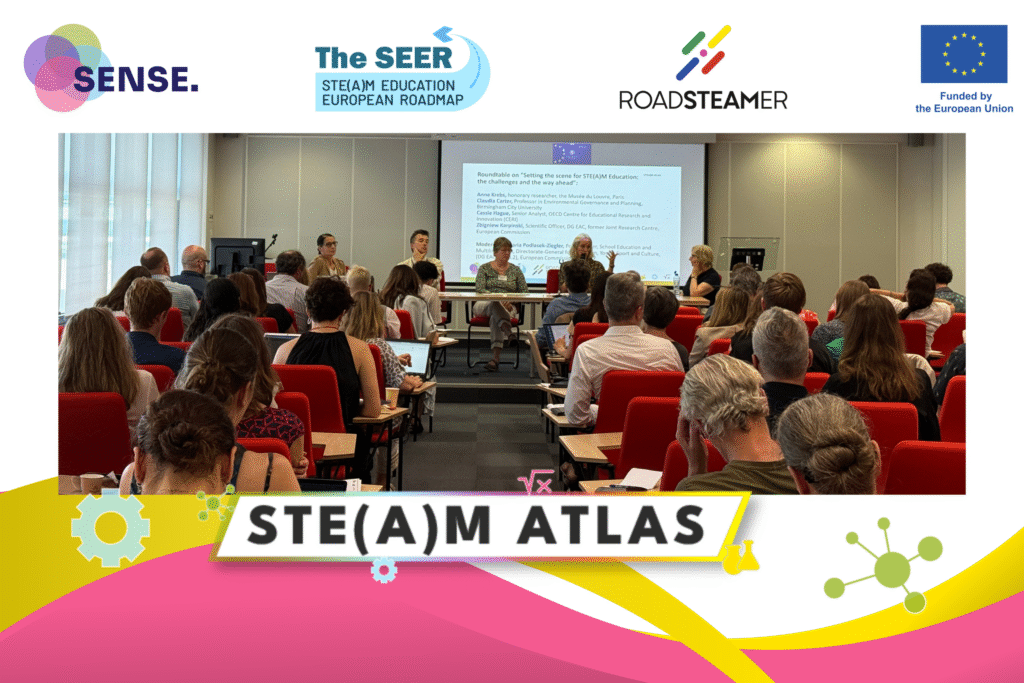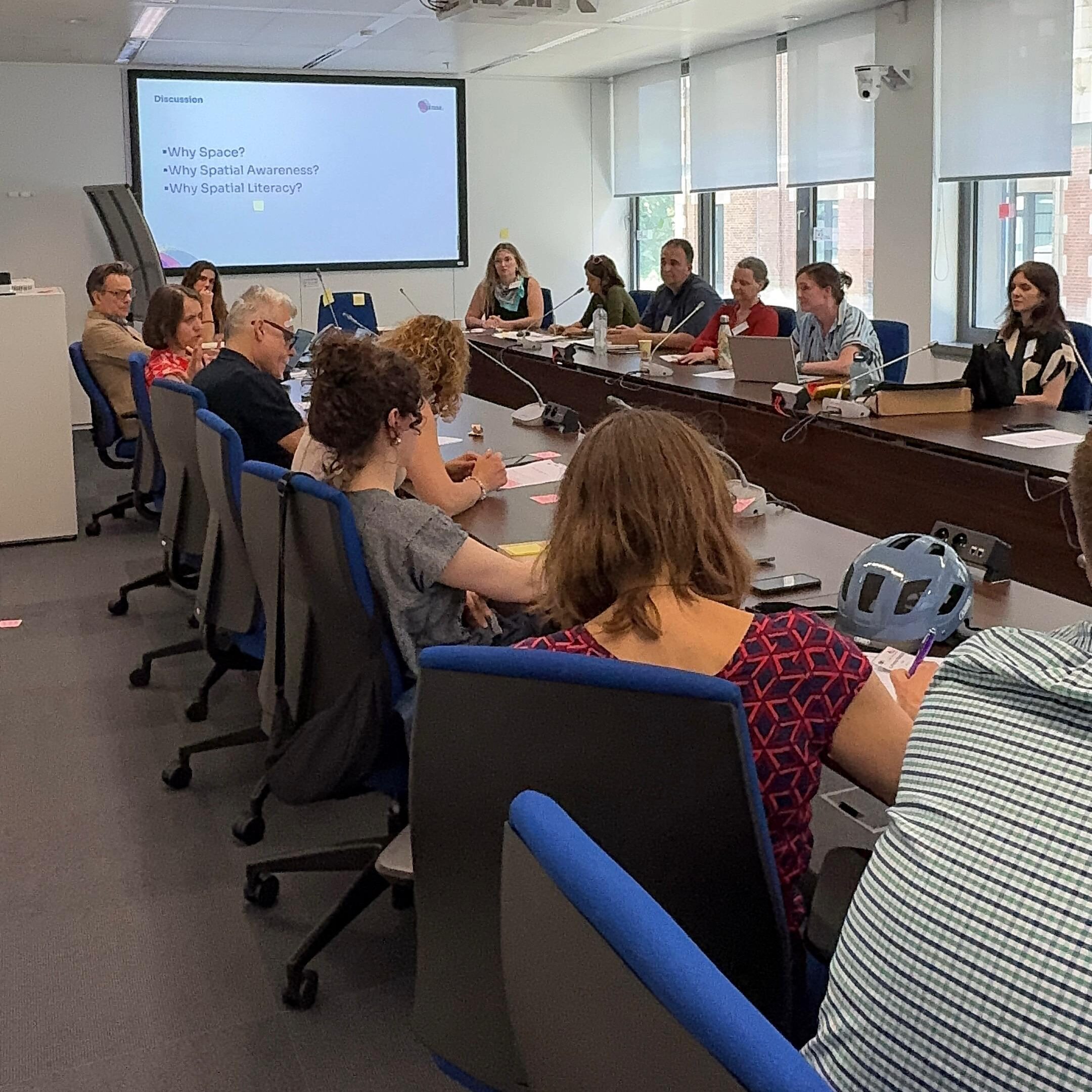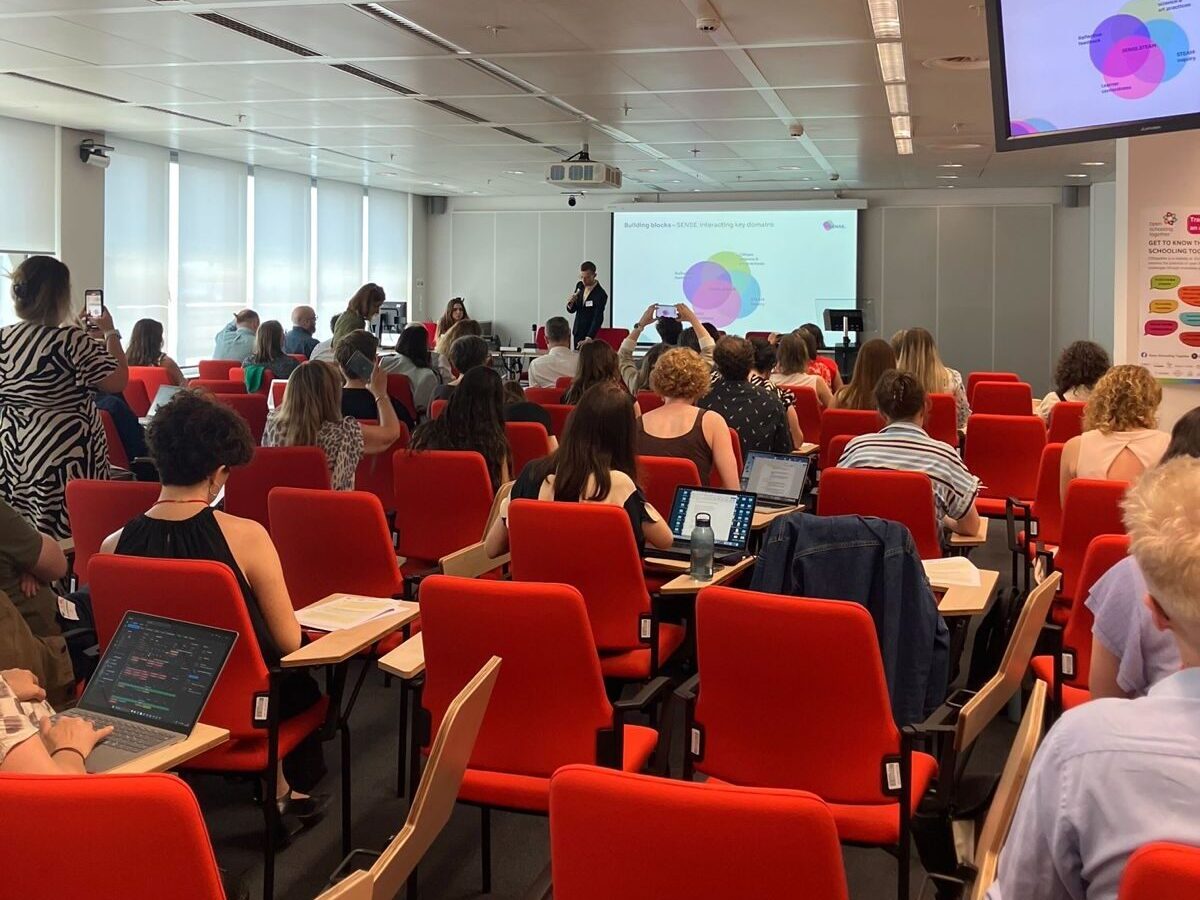STE(A)M Atlas event: Three ROADMAPS. One destination

On 2 July 2025, the STE(A)M Atlas event brought together leading voices from across Europe to explore the future of STE(A)M education through creativity, inclusion and systemic collaboration. Hosted in Brussels, the event convened policymakers, researchers, educators, cultural actors and civil society stakeholders to share insights and align efforts toward a more integrated and equitable educational landscape. At the heart of the event were three Horizon Europe projects: Road STEAMer, SENSE and SEER, each presenting its own roadmap for advancing STE(A)M learning. While their approaches reflected different contexts and priorities, all three roadmaps converged on a common goal: transforming education to better serve learners, communities and the evolving needs of society. The event featured keynote speeches, expert roundtables, participatory workshops and a dynamic open-format session designed to foster dialogue, innovation and long-term impact.
Opening
Maria Mecenero from DG RTD opened the event by emphasizing that European leadership in Research and Innovation relies on inclusive and high-quality education. She called for a shift in educational approaches to foster creativity, systems thinking, collaboration and societal purpose, highlighting these as essential skills to drive Europe’s green and digital transitions.
Keynote
Francesca Maltauro, Deputy Head of Unit for Digital Education at the European Commission, delivered a keynote emphasizing that STEAM education is both urgent and foundational for Europe’s future. She highlighted how technological change, geopolitical pressures, and climate challenges require a strong focus on equipping people with relevant skills. Her message reflected broader EU strategies, including the European Skills Agenda and the Action Plan on Basic Skills. She stressed that Europe’s ability to lead economically, technologically, and socially depends on empowering its citizens through modern, inclusive, and skills-focused education.
She presented three strategic objectives of the STEAM Education Strategic Plan. The first, Lead, aims to make STEAM a clear priority in education policy and includes shared EU targets for vocational, tertiary, and doctoral education, with specific attention to increasing female participation. The second, Level Up, focuses on strengthening the talent pipeline by creating STEAM Education Centers, supporting digital competitions, and piloting mentoring programs that link education to real-world applications. The third, Lift Barriers, addresses the underrepresentation of girls and other groups in STEAM fields, noting that only 31 percent of STEM students and fewer than 16 percent in some advanced roles are women. Initiatives such as Girls Go STEM, which aims to train one million girls by 2030, and a dedicated STEAM Week are designed to increase visibility and inclusion. Francesca concluded by highlighting the importance of creativity in education and affirmed that integrating the arts into STEM is essential for preparing learners to navigate and shape the future.
roundtable – “Setting the scene for STE(A)M Education: the Challenges and the way ahead”
The roundtable of the event, moderated by Maria Podlasek-Ziegler, Policy Officer at the Directorate-General for Education, Youth, Sport and Culture (DG EAC.B.2), framed the debate around integration, purpose, and inclusion in STE(A)M education systems.
Dr. Claudia Carter, Professor in Environmental Governance and Planning at Birmingham City University, opened the discussion with a reflection on the barriers facing interdisciplinary education. Drawing from her experience in higher education and transdisciplinary projects, she highlighted how siloed thinking, institutional competition, and rigid structures hamper collaborative learning. She emphasized the need to build inclusive environments in higher education, not only through policy but through trust-based and value-driven collaboration. Her work in the STEAM-Inc project illustrated how partnerships between science, arts, and technology can challenge conventional divides and broaden the understanding of what STE(A)M can mean.
Dr. Carter also addressed the philosophical tension between competitive and collaborative drivers within STE(A)M initiatives. She called for a redefinition of success within education systems, one that values collective creativity and social responsibility alongside technical achievement. Reflecting on Leonardo da Vinci’s multidisciplinary legacy, she argued for an educational model that recenters human experience and societal needs in innovation. The roundtable, she noted, provided a rare opportunity for experts from different backgrounds to engage deeply across perspectives and motivations, highlighting the need for continuous support and structural reforms.
Cassie Hague, Senior Analyst at the OECD Centre for Educational Research and Innovation (CERI), brought an evidence-based perspective on the role of creativity and critical thinking in STE(A)M education. Drawing from a decade of OECD research across 24 countries, she stressed that embedding creativity into teaching requires more than adding an “A” to STEM. It requires intentional, structured pedagogical design. According to Hague, projects that foster creativity must ensure teachers are equipped to model, scaffold, and assess creative thinking processes, tasks that demand professional development and clear educational goals.
Hague underscored the necessity of aligning subject knowledge with transferable skills. She noted that students are more likely to thrive when they are encouraged to develop multiple solutions, reflect on their process, and embrace frustration as part of learning. This applies particularly to marginalized groups. OECD findings show that girls often report higher anxiety and lower confidence in STEM settings, while boys tend to disengage. To support inclusive learning, Hague advocated for gender-responsive teaching practices and classroom environments that balance freedom and structure.
Zbigniew Karpiński, Associate Professor at the Institute of Philosophy and Sociology of the Polish Academy of Sciences, offered a sociological lens on inequality in STE(A)M education. He emphasized that educational exclusion is rooted in unequal access to public infrastructure such as libraries, science centers, and cultural institutions. He called for investment in environments that foster curiosity and support informal learning, especially in under-resourced areas. His analysis revealed that barriers to participation are often shaped by local contexts and invisible cultural signals that discourage certain groups, particularly girls, from pursuing science and mathematics.
Professor Karpiński argued that confidence, not competence, is the defining issue in gender gaps within STEM. He described how implicit biases from educators and societal expectations can erode students’ self-perception, influencing their decisions long before university. He emphasized that the collaborative nature of science is often overshadowed by the stereotype of the lone genius, a narrative that alienates learners who might otherwise thrive in team-based, inquiry-driven environments. Building inclusive STE(A)M pathways, he suggested, requires reshaping how we talk about scientific work and who belongs in it.
Anne Krebs, Honorary Researcher at the Musée du Louvre, spoke about the underexplored relationship between science and art museums. She noted that many small museums across Europe lack the resources or confidence to engage with science education due to their traditional focus on the humanities. Krebs argued for the co-design of programs by artists and scientists to foster mutual respect and more dynamic learning experiences. She emphasized that inclusivity in STE(A)M also means rethinking who delivers content and how institutions work together.
Drawing on her experience in socially engaged programming, from hospitals to prisons, Krebs highlighted the emotional and social impact of STE(A)M education. Programs developed in collaboration with ministries of health and justice have shown that interdisciplinary approaches can reduce anxiety, increase confidence, and support wellbeing. She called for a holistic approach to evaluating STE(A)M’s impact, one that values creativity, community interaction, and emotional development alongside academic results. Museums, she concluded, are not peripheral to science learning but can be powerful platforms for social change.
This multi-perspective roundtable illuminated the complexity and potential of STE(A)M education in Europe. As the session concluded, one shared conviction emerged: transformative education requires sustained collaboration, structural support, and commitment to inclusion.
participatory parallel sessions
Three dynamic parallel sessions provided a space for participants to explore the essential elements needed to support the integration of STE(A)M education.
SENSE. – SENSE. engaged all participants in a series of participatory exercises to uncover the cultural and imaginative dimensions of space in education. By thinking critically about space as an active component of any social setting, SENSE empowered participants to consider new pathways in teacher education; drawing together students and teachers in communities of practice, evidence was given about how perceived barriers to STEAM education can be transgressed. By foregrounding space in STEAM education, SENSE provided a unique take on the project which recognises the importance of diverse sense experiences in place, and prioritises the diverse needs of people and communities across Europe.

The SEER – Participants discussed primary teachers’ fear of STEM, barriers to integrating STEM in secondary schools, and difficulties in involving industry and experts. Tackling all these requires both curricular reform and cross-sectoral mobilisation for their solution, aligning directly to the recommendations outlined in the SEER’s Roadmap.
Road-STEAMer – Participants explored the question: what do we really mean when we talk about STEAM? Using the conceptual characteristics and criteria developed by the Road-STEAMer project to map and analyze STEAM practices across Europe, the group examined how key elements, such as creativity, equity, collaboration, real-world connections, thinking-making-doing, and interdisciplinary relationships, manifest in different projects and experiences, and considered their relevance in diverse contexts.
spotlight on STE(A)M from different angles
In the plenary session, each of the three Horizon Europe projects, Road‑STEAMer, SENSE., and SEER, unveiled its STE(A)M roadmap, with a collective mission captured as “Three roadmaps, one destination”. Road‑STEAMer presented policy-oriented strategies focused on four priority areas: embedding STE(A)M into funding and regulations, enhancing teacher training, aligning educational outcomes with market needs, and promoting equity and inclusion. SENSE. proposed participatory education pathways emphasizing social imagination and spatial literacy, and advocated for inclusive policymaking involving schools, museums, industry, and communities. Meanwhile, SEER introduced its framework to empower educational stakeholders through tools like an Impact Assessment Mechanism and groundwork for a STE(A)M certification scheme.

Connecting visions and forging innovation
One of the most engaging moments of the STE(A)M Atlas event was an open-format session designed to spark collaboration, insight, and shared vision. Titled Connecting visions and forging innovation, this dynamic forum invited participants to move freely between seven discussion stations, each centered on a key theme relevant to the future of STE(A)M education. Topics ranged from integrating formal and informal learning, to gender and social inclusion, to the role of cultural institutions in participatory education. One station remained open for emerging ideas, ensuring space for fresh perspectives sparked by earlier sessions.
Facilitated by the SENSE. team and with support from the sister projects, each flip chart became a hub for exchange where attendees could contribute thoughts, respond to questions, and build on one another’s insights. Participants were encouraged to stay with a single topic or explore multiple themes, fostering fluid conversations and cross-sector inspiration. This session captured the spirit of co-creation, with pens in hand and ideas flowing across disciplines and roles. It concluded with a collective wrap-up where highlights from each poster were shared, distilling a wide range of voices into a shared vision for STE(A)M innovation in Europe.
Closing statements
The final session of the STE(A)M Atlas event brought together leading voices from across the initiative to reflect on key outcomes and the road ahead. Closing statements were delivered by Francesco Mureddu, Vice-President for Development at The Lisbon Council and Coordinator of the Road-STEAMer project; Professor Lydia Schulze Heuling of Western Norway University of Applied Sciences, Coordinator of the SENSE project; Agueda Gras-Velazquez, Science Programme Manager and Head of the Science Education Department at European Schoolnet, and Coordinator of the SEER project; and Roberta Monachello, Project Adviser at the European Research Executive Agency (REA), Unit REA.C4 – Reforming European R&I and Research Infrastructures, European Commission. Together, they emphasized the importance of aligning innovative practice with policy, and reaffirmed the role of the STE(A)M Atlas as a foundation for long-term cooperation and system-level impact in European education.
conclusions
- A Shared Vision for STE(A)M Integration
The event reaffirmed the need for a coordinated European approach to STE(A)M education, built on shared values of inclusion, creativity and relevance. The three roadmaps demonstrated that while approaches may vary, the destination is common: a more integrated, equitable and future-oriented education system. - Bridging Practice and Policy
Discussions throughout the event highlighted the importance of aligning grassroots innovation with policy frameworks at national and EU levels. From classroom-level experimentation to strategic planning, the STE(A)M Atlas showcased how local initiatives can inform system-wide transformation when supported by coherent governance and funding structures. - Creativity as Core Competency
Across plenaries and workshops, participants consistently stressed that creativity must be at the heart of STE(A)M, not as a supplement but as a core pedagogical focus. The “A” in STE(A)M was validated not only as a symbol of artistic integration but as a driver of critical thinking, collaboration and emotional engagement. - Inclusive Talent Pipelines Are Essential
Equity was a central theme, with attention given to gender gaps, underrepresented learners and systemic access barriers. The event reinforced the urgency of rethinking recruitment, retention and recognition across the STE(A)M ecosystem to ensure diverse learners can thrive from school to the labor market. - The Atlas as a Launchpad
Rather than marking a conclusion, the event positioned the STE(A)M Atlas as a launchpad for future action. Participants left with renewed commitment to cross-sector collaboration, empowered by tools, roadmaps and community connections that will shape the next phase of Europe’s STE(A)M journey.
